LIRR Signal
Photos
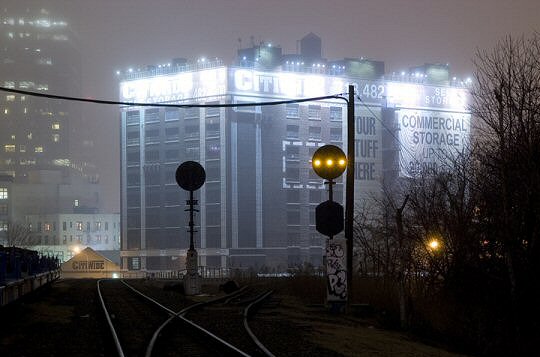
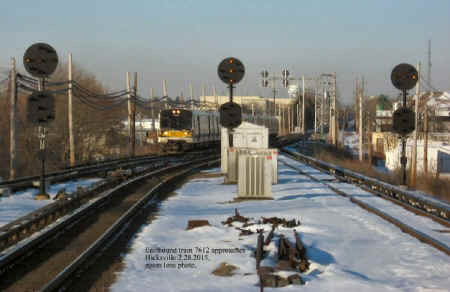 |
|
Signal bridges were usually numbered
west to east. Automatic block signals (and distant signals) were usually
numbered to the nearest milepost and all originally had a prefix
letter for the branch, as follows:
A-Atlantic
B-Bay Ridge
C-Central
E-West Hempstead (NY Bay Extension RR), no automatic signals but a few
distant signals.
F-Far Rockaway
G-Main Line (later, no prefix letter)
H-Hempstead
M-Montauk Cut-Off
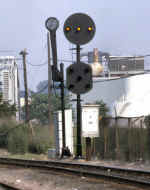 Smash board and eastbound Signal #006 at Dutch Kills Drawbridge (swing
bridge).
Smash board and eastbound Signal #006 at Dutch Kills Drawbridge (swing
bridge).
View southeast at Dutch Kills 06/1981
Photo: S. Goldstein
N-Port Washington (North Side)
O-Oyster Bay
P-Port Jefferson
R-Rockaway Beach
S-Montauk (South Side RR)
For example, signal S243 would be
nearest to milepost 24.3. Also, even numbered signals are usually
eastbound and odd numbered westbound. Info: Jeff Erlitz
Amityville-Copiague-Lindenhurst was
the "test site" for no wayside automatic block signals. It
was probably designed in 1968 or before since the shoo-fly tracks for
this section were placed in service in October 1968. I'm guessing that
the railroad did not know for sure that the FRA, or whoever, was going
to approve the use of no wayside automatics so they designed the new
elevated with the provision for them. This was the first section of
railroad to operate under Rule 410.
The following year, in May 1974, the
automatics came out of service from Queens to Divide and in November
1974 from Hall to Queens.
Oyster Bay Branch, Montauk Branch
from Babylon to Y and west of Jamaica are the last bastions of
automatic block signals, Rule 251. Of course, the Main Line west of
Jamaica also but that's not 251 territory.
The Central branch still has its
automatic block signals, such as C229 distant signal to Beth. It's
your basic Rule 261 automatic block signal system with out speed
control. The automatic block signals for the
Atlantic branch between Hall and Valley were replaced in the late
1990's, about the same time Hempstead branch automatic block signals
were replaced.
Far Rockaway Branch
lost its automatics 2/4/1984
Long Beach Branch lost its
automatics 12/2/1982
Hempstead Branch was after
1990 Research: Jeff Erlitz
|
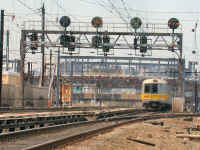
West
end of Harold looking west |
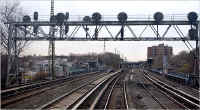
Winfield looking west towards Woodside
11/21/2006 |
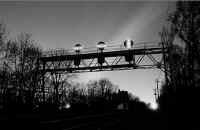
Bethpage Jct. view west
|
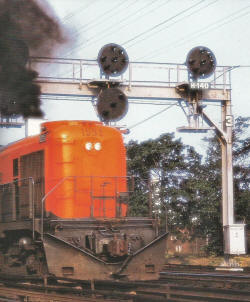
Bellerose Signal H-140 8/1967
(Brennan-Erdman)
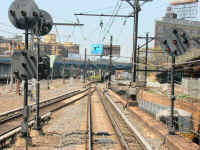
Looking west on Line 2 in F Interlocking, LI City.
Home signal 708W on
the right and 704W on the left.
The Line 2 Connection track is coming
in on the left.
Info: Jeff Erlitz
|
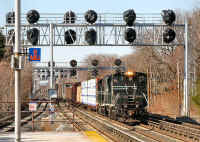
Bellerose 2/14/2008
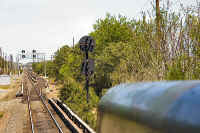
JS interlocking east Deer
Park
|
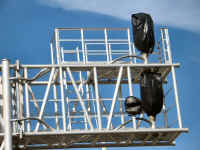
PD in service 4/27/2006 Photo/Archive: Nick Kudrey
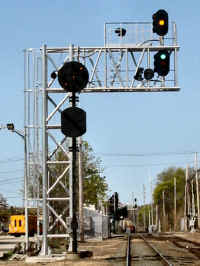
LIRR new signal installation Patchogue
4/29/2006 Photo:
Paul Strubeck
|
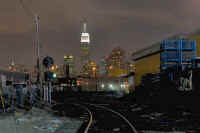
West
end of Dutch Kills Drawbridge looking west
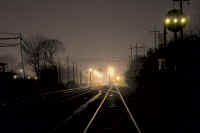
View
west at the former Farm 1 Interlocking,
just east of Farmingdale station
|
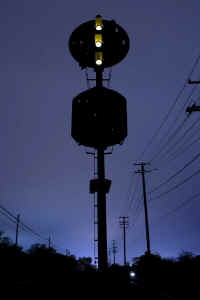
Position light at dusk Photo: Joe Tischner
|
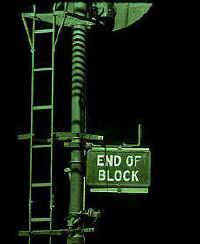
End Of Block Port
Jefferson 9/1985
|
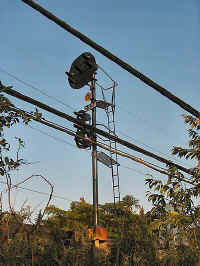
MP34 Central
Extension 10/23/2010
Photo: Al Castelli
|
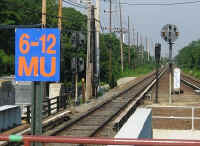
View Track 1 platform east Seaford 6/27/2009
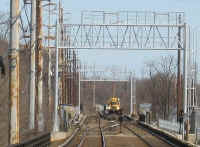
View East from
Wantagh Station 3/23/2009
|
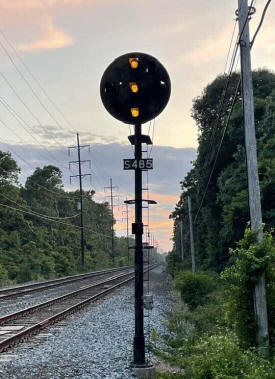
Signal S485 Locust Ave., Oakdale view W 6/19/2023
Photo/Archive: Timothy Hosey
|
|
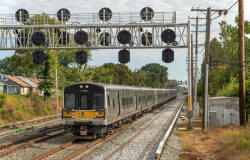
M7 #7199 Train #9713, one of the "extra" Hempstead to
Penn Station trips that operate on the "MLX" weekends when there is no
service on the Main Line between New Hyde Park and Hicksville. View
E at Signal Bridge 3, Queens Interlocking west of Bellerose station, on the border of Bellerose Terrace (on the
left) and Elmont (on the right). 10/24/2021 Info/Photo/Archive:
Jeff Erlitz
|
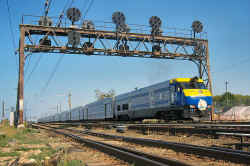
Cannonball westbound
under signal bridge #18
LI City 05/11/2010 Photo: Joe Tischner
|
1st
signal: unidentified
2nd signal = #18
3rd signal = #N18 (Port Washington Branch)
4th signal = #NY248 (NYCRR)
Signal
bridge #18 east
side of “HAROLD” tower (or where HAROLD used to be) at
the loop tracks leading into Sunnyside yard, close to 42nd street in
Woodside, Queens.
Research: Dave
Keller
|
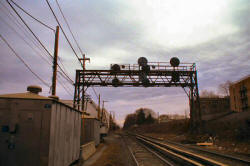
Roslyn Rd. signal bridge View W 2/17/2008
Photo/Archive: William
Gilligan |
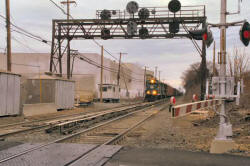
Roslyn Rd. signal bridge View E 2/17/2008
Photo/Archive: William
Gilligan |
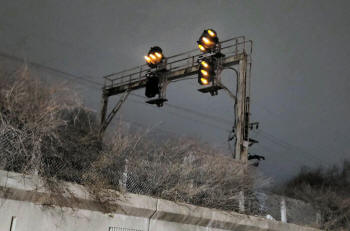
Babylon Signal Bridge #1 Signal 10 Stop - Signal 12
Approach-Medium
aspects 3/08/2022
Photo/Archive: Craig Lignelli |
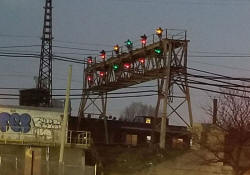
LIRR signal gantry, Main Line, Woodside,
Winfield
mile 3.5 at Queens Boulevard, 4/8/2023
Photo/Archive: Kevin Wong |
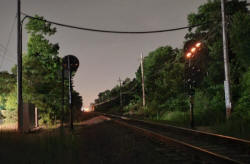
KO 11W BLS 7/01/2022 Rule 285: APPROACH
Photo/Archive: Jason Baxter |
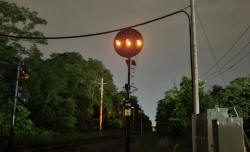
KO 11E BLS 7/01/2022
Photo/Archive:
Jason Baxter |
|
(ABOVE) Looking west
towards New York, left to right:
Track 4 (eastbound local Main Line): red over red (wrong way)
Track 2 (eastbound express Main Line): red over red (wrong way)
Track 1 (westbound express Main Line): yellow over green, diverging
route to Grand Central
Track 3 (westbound local Main Line): green over red, through route to
Penn Station
Port Washington eastbound track: red over red (wrong way)
Port Washington westbound track: yellow over green, diverging route
to Grand Central Info: Kevin Wong
|
-Signal-Bridge-6-JeffErlitz_small.jpg)
Divide Interlocking (Station 4) - Signal Bridge 6
Home signals 6L on Track 2 and 4L on Track 1
Long before the electrification to Ronkonkoma (note only Track 2
has third rail, for turn-backs) and long before the re-signaling of
Divide and the creation of Divide 6 - January 28, 1979
Photo/Archive: Jeff Erlitz |
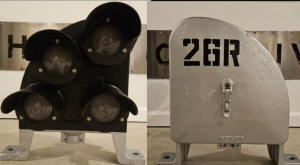
Jamaica JAY Interlocking Signal 26R
Restoration/Photo/Archive: T. J. Mahan |
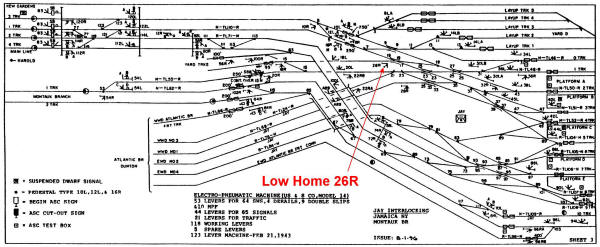
JAY Interlocking Dwarf Signal 26R ex-location - 8/01/1996 Info: T.J.
Mahan
|
|
LIRR refers to
them as a “Low Home” signal. “Low” because it indicates
“slow/restricted speed and unless otherwise posted is displayed lower
than pedestal/full size position light signals. “Home” because
they display the most restrictive aspect of Stop Signal. All
“Home Signals” per definition on the LIRR display “stop signal” as
their most restrictive aspect. On the PRR, Amtrak and NS
these signals are referred to by the PRR jargon of “Dwarf signal” and
Low Home/Dwarf signal are used interchangeably.
The reason for the silver
back was to make the back side of the signal clearly distinguishable
when running against the normal direction of traffic. The signal
indicated in red is illuminated west and therefore
it would be governing eastward movements from Richmond Hill (receiving
yard) going east protecting the ladder (double slip switches).
5/2023 Info: Joe Vila |
|
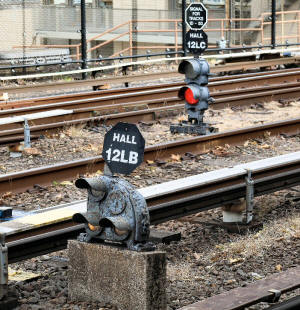
Jamaica HALL - Dwarf Interlocking Signal 12LB old style PL-4
11/04/2023 Photo/Archive: Thomas Farmer
|
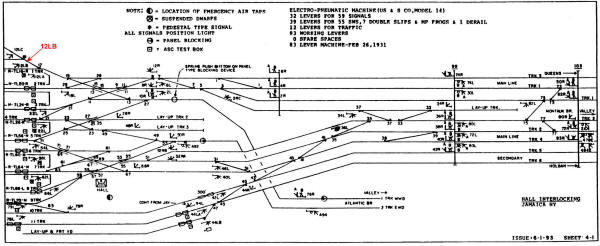
HALL Interlocking Dwarf Signal 12LB - 6/01/1993
Archive: Jeff Erlitz
|
|
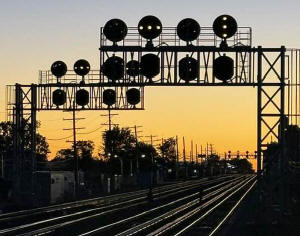
Elmont-UBS - 10/17/2025
Photo/Archive: Timothy Hosey |
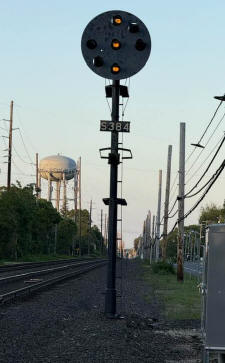
S384 West Islip 5/26/2025 - Photo/Archive: Timothy Hosey |
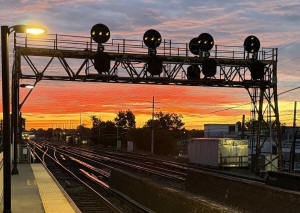
Queens Village - 9/26/2025
Photo/Archive: Timothy Hosey |